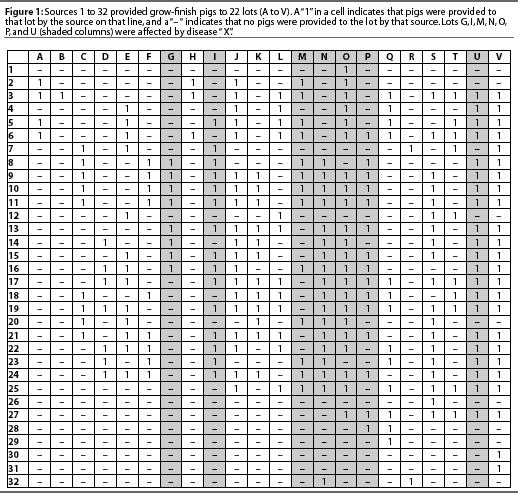Journal of Swine Health and Production
What’s your interpretation? |
Non refereed |
Several lots of grow-finish pigs have been affected by disease "X". For each lot of pigs (A to V), the figure shows the sources of pigs (1 to 32) and whether or not each source provided pigs to a particular lot (white cell: no pigs from the source on that line; colored cell: lot received pigs from the source on that line). Lots G, I, M, N, O, P, and U were affected by disease " X". On the basis of this data, can you determine which origin is the source of the contamination?

The contingency table: an epidemiological tool
To solve this problem, determine if there is an association between the presence or absence of a given source of pigs and the presence or absence of disease "X" within a lot of grow-finish pigs (Figure 1). For this purpose, we will use the epidemiologist’s work horse, the two-by-two contingency table. The basic approach to the statistical analysis of such a table is to first determine the probability that the distribution is due to a random process. The tests most often used for this purpose are the Chi square, the Chi square corrected for continuity, and Fisher’s exact test. The Chi square corrected for continuity is useful when cell values are less than 30. The Fisher’s exact test is used when the expected value of any one cell is less than 5. Because our contingency table has small numbers, we must use the Fisher’s exact test. Thus, for each origin, we make up a two-by-two table, as illustrated by Table 1 for Source 9.


The results of using the contingency table and Fisher’s exact test for each source show that Sources 8, 9, 10, 11, 13, 15, 16, 23, and 24 are associated with the presence of disease "X" (P<.05). In addition, if you carefully examine the data, you will notice that barns that received pigs from Source 9 also received pigs from Sources 10 and 11.
This data is from 1987, the last outbreak of swine dysentery I have had the "pleasure" to deal with. On the basis of this initial analysis, it was found that sources 8, 11, 13, 15, 16, 23, and 24 shared a common source of replacement stock that was infected with swine dysentery. Sources 9, 10, and 11 shared the same truck to transport pigs to the grow-finish sites. To stop the ongoing problem of swine dysentery, the grow-finish sites were maintained on preventative medication with strict cleaning and disinfection, and the sources of contaminated pigs underwent an exhaustive eradication program.
Robert Charette, DVM, MSC
Clinique Vétérinaire St-Thomas
755A Duplessis
St-Hyacinthe, Québec
J2S 8B1 Canada
Tel: 450-796-2552; Fax: 450-796-1319